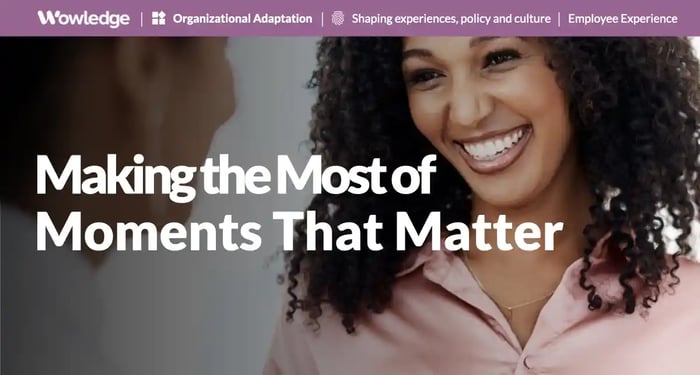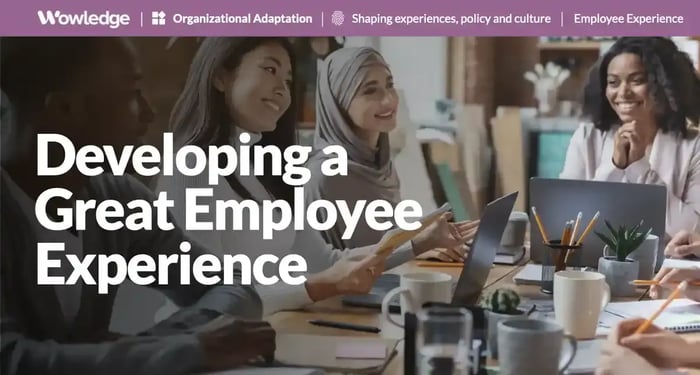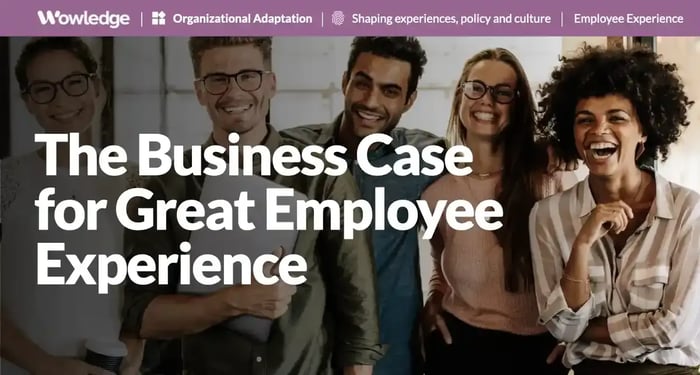Table of Contents
- What is employee listening
- The value proposition for adopting employee listening strategies
- The current state of employee listening
- Challenges with current methodologies
- Types of listening tactics
- Making the best use of employee listening
- 1. Define the listening channels that make the most sense
- 2. Clarify the exact purposes for doing it
- 3. Create a continuous listening strategy
- 4. Use multiple listening “channels”
- 5. Be quick, agile, and communicative
- 6. Provide easy access to all employees
- 7. Engage with legal and IT teams on privacy and data protection
- Relevant Practices & Tools
- About Wowledge
Collecting employee feedback and sentiment through surveys is a time-honored technique to get a “finger on the pulse” of the workforce and generate useful insights into employee opinions. They were designed to provide unfiltered feedback from employees levels below them, often unavailable to executives from those reporting up to them. Feedback and insights into the work climate, culture, and mood from those working at levels below the top leaders were and continue to be the primary objective of those efforts. Employee listening has a history, but it is changing.
In the past, those collective opinions were solicited annually. After months of analysis, executive review, and “slicing and dicing” for lower-level leaders and managers, they were presented to them for action planning.
However, several factors have generated a higher awareness and appetite for more current insights into employee opinions and perspectives on their workplace and work lives. Several trends have pushed this significantly over the past several years.
- The rapidly changing employment relationship offers a significant challenge. New generations of workers are more willing to leave to find better opportunities, treatment, and cultures. Their expectations are driving rapid shifts in the terms and conditions of employment and how they want to be treated, developed, advanced, and managed.
- An increased awareness and focus on the employee experience (EX) and engagement as drivers of employee productivity, retention, and performance.
- The significant expansion, advancement, and availability of polling and real-time analytics technologies have revolutionized employee listening. These technologies enable us to collect, process, and distribute data more quickly, providing us with real-time insights into employee opinions and perspectives on their workplace and work lives.
- Employees' widespread expectation of “here and now” input, data, and insights due to their widespread use of consumer-grade technologies and resources (e.g., smartphones, tablets, internet, search engines, social networks).
Employers are increasingly navigating this sea change by expanding and enhancing their ability to assess the “mood” of their workforce beyond the one-per-year employee survey check-in, and leading practices have emerged that guide the organizations wishing to leverage such insights from employee listening better.
What is employee listening
“Employee listening” encompasses how a company solicits, collects, and manages employee opinions and perceptions. It is best executed as a strategy, with disciplined and planned processes, vehicles, technologies, and analytics designed to enhance the employee experience and, ultimately, drive business outcomes. At its most robust, it is focused on generating real-time and near-time insights into employee perceptions across the range of experiences in their work lives. Topics covered can be as varied as the quality and efficiency of their work processes, feedback on their new hire onboarding experience, how well they understand the organization’s mission, and their satisfaction with learning programs.
At its core, employee listening aims to keep a finger on the pulse of employee sentiment, mainly to understand where their frustrations, well-being pains, and performance and productivity shortcomings can be addressed and how their preferences, positive experiences, and happiness can be enhanced and duplicated.
Employee listening should be designed to help leaders understand the extent to which employees’ workspace, work content, and work environment operate in the intended and desired manner. This translates into assessing how well the culture, managers, employee work commitment, and performance capabilities are being adequately leveraged. The objective is to create an environment where open and honest communications are exchanged proactively and continuously to help identify issues and address them quickly and appropriately in a structured and measurable manner.

The value proposition for adopting employee listening strategies
Employee listening can bring value to organizations by generating an understanding of the challenges and issues they face in conducting their work and how to rapidly identify and rectify sources of productivity losses. Where such information is often not regularly sought out (or worse, dismissed) by their direct managers, this represents an opportunity to break down unseen barriers to process improvement.
Furthermore, when combined with responsiveness (to solve the issues), listening strengthens the employer-employee relationship (by asking) and trust (by acting). That, in turn, creates a more constructive and positive environment and culture that is focused on easing otherwise barriers to more efficient and effective job or administrative workflows, whether related to improving HR processes or business processes, engaging employees in those efforts yields substantial benefits.
The added value to HR is that owning and operating the listening ecosystem can significantly enhance its contributions to achieving business objectives.
The data coming from organizational research supports this value proposition. For example, 90% of workers report being likelier to stay at a company that takes and acts on feedback. And 44% of surveyed employees who said that their organizations were “horrible” at acting on their feedback are looking for new jobs vs. 28% who said theirs were great at it. Additionally, robust listening has been shown to improve the employee experience and related engagement levels when used to enhance processes, practices, and programs. For example, when employees feel that their “voices are heard” at work, they respond with 74% higher engagement levels, 71% more willing to convey their ideas and feedback, and 74% report feeling more effective in their jobs.
Business results also follow. Another study found organizations that regularly ask their employees for feedback (and act on it) are three times (3X) as likely to meet or exceed their financial targets as those that do not. Those companies are ten times (10X) more likely to generate high customer satisfaction and retention. The organizations with the highest maturity and employee listening discipline also enjoy significantly higher profitability, innovation, and adaptability to change.
The current state of employee listening
While annual employee surveys may seem universal to HR professionals from larger organizations, the numbers from across the spectrum of organizational size, spread, and industry segment appear less so. Although 94% of companies report conducting formal employee listening efforts, the methods for collecting those insights appear to be shifting. For example, Gartner reports that while 74% of surveyed organizations use annual formal, large-scale employee engagement surveys, that is 15% lower than only five years earlier. Qualtrics reports that 48% of employees are asked for feedback more frequently than once a year, up significantly from the 35% the prior year. 60% of companies share that they use spot surveys to check in with subsets of their workforce quarterly or more. Interestingly, it also noted that 59% of organizations gather engagement data from other (non-survey) sources.
Challenges with current methodologies
Given the widespread use of surveys and other methods, one might assume that employees are comfortable using them. However, 86% of employees surveyed worldwide feel that they are “not heard fairly or equally,” with another 47% reporting that underrepresented (minority) workers seem to have it worse.
Trust seems to be at play here, with another study finding that employee comfort with communicating their opinions was lower than anticipated. As many as 34% of surveyed workers stated that they would rather leave their current role rather than share their concerns and views with management.
The previously cited trend away from a reliance on the long-form annual engagement survey is real and, from experience, is becoming quickly outdated. The primary issues concern the insights' timeliness, relevance, and utility. For example:
- The planning, administration, and development timeline is long and often arduous. Given the number of stakeholders and users of the output, significant back-and-forth is common when agreeing on the survey questions. The time and effort required to tabulate, parse, analyze, and create sub-reports by leader, function, business unit, location, and department are often substantial.
- The results are often complex and dated. Since many annual surveys are designed to be comprehensive and collect insights for various stakeholders, they can be overly complex to summarize and determine action priorities. Given the time lag between design, administration, and results presentation, there is a risk that the problems are dated and issues have been overtaken by new or more pressing matters.
- The data may be less reliable, given the survey length. Surveys of 70-120 questions can inflict fatigue and a lessening of interest as they are completed, which may also impact participation and completion rates. Such survey design decisions may create a situation where responses are dominated by those on either the high (happiest) or low (unhappiest) spectrum of opinions and perceptions.
- Surveys offer a limited scope of information. Surveys are often designed with “forced choice” responses, enabling quicker and numerically based data analysis. Unfortunately, reliance on these alone can lead to fewer nuanced opinions and perceptions. Their value in capturing a broad range of insights is exceptional, but the ability to make inferences into the gray areas of employee sentiment is limited.

Types of listening tactics
The range of opportunities to collect insights into the levels of employee engagement, satisfaction with management, work processes, and HR practices and programs is reasonably broad. Moving beyond a static (one-time annual) view of employee sentiment to a more dynamic, timely, and objectively more accurate picture can be achieved using multiple data collection vehicles. Many exist, and include:
Surveys
These have the advantage of enabling large-scale assessment of key issues and questions across the entire workforce, enabling (primarily) quantitative comparisons between employee segments, levels, functions, and roles. Their anonymous nature tends to generate more honest and objective input from employees who might be reluctant to share verbally or directly.
- Long-form (comprehensive). These 50-120-question surveys are broad and generate insights into the same topics across a workforce. They cover satisfaction with the quality of management, key HR processes, work duties and environment, development and advancement opportunities, and the organization’s mission, direction, and objectives.
- Pulse. Short (e.g., 2-5 questions), fast and easy to design and administer. These support the rapid collection of varying topics and insights needed to address subject matter unique to smaller segments (e.g., critical roles, high turnover groups) and are more likely to generate high response rates.
- Purpose-built. Designed for specific and critical areas of interest in higher-volume occurrences, such as why people quit, are planning to stay, or their evaluation of critical administrative processes, systems, or programs. These include surveys for terminations (exit interviews), intention-to-stay, HR processes (onboarding, open enrollment), employee and candidate experience, alumni feedback, and other process-specific topics.
- 360-degree feedback. Provide multi-rater assessments of an individual’s skills, capabilities, performance, potential, behavior, and style, typically by small groups of employees with experience working with an individual. Examples are surveys of managerial effectiveness, project member performance and contribution, high-potential assessments, and leadership competency assessments. When aggregated, they can provide leadership and management group skill gap assessments.
Live, direct interactions
These engage employees in direct conversations, where standardized questions can elicit unique and nuanced insights into perceptions. The added benefit is the ability to ask follow-up questions to clarify and deepen the understanding. They can be used as stand-alone events or follow-up to other data collection activities to better understand what is behind employee perceptions, behaviors, or reactions. What is lost in anonymity is balanced with what is gained in their spontaneity and ability to generate unique and often unexpected insights.
- Focus Groups. These engage small groups (8-15) of employees, often in similar functions, functions, or job levels, to generate better insights into how they react to events or environmental circumstances at a given time.
- Skip-level sensing sessions. Meetings with groups of employees two or more levels below a leader who answer (and often ask) questions without their direct manager(s) present. These provide leaders with un (or less-) filtered insights into employee concerns, preferences, and needs that might otherwise be concealed by their manager’s lack of transparency and comfort with sharing with the leader.
- Process-embedded conversations. Calls come to either HR, IT, or other help desks, which can provide insights into people (managers, peers, and teams), systems, process dysfunction, issues, inefficiencies, and ineffectiveness. Larger organizations and shared services functions may field (and record, track) such calls and investigate them for further action and resolution, such as system troubleshooting or employee relations issues.
- Manager-employee performance check-ins. When documented and tracked, their frequency and content can provide extremely useful data about employee and manager performance, skills, development needs, and evaluation effectiveness.
Systems workflow-related
These are options for indirectly collecting insights without necessarily asking employees specific questions. They may be survey questions embedded in automated processes, such as after completing an eLearning program, or may be automatically generated from online work or administrative activities without direct acknowledgment. Data related to the frequency, length, and type of data accessed from business and HR-related systems can provide insights into worker productivity, resource needs, concerns, and engagement, especially when integrated with survey responses.
- Internal collaboration and social media platforms. These can generate insights into employee contributions, project participation levels, satisfaction, and concerns related to management, treatment, company direction, or handling of production or customer requirements.
- HR systems. The extent to which employees access and use various HR systems can provide clues to employee retention (internal job searches), skills and development needs (knowledge management system searches), interest in growth (LMS course or certification participation), ambitions (career or skill profile updates), and well-being issues (EAP, absenteeism, and sick leave requests).
- Business communications systems. Employee email use and content from IM or texting, blogs, and social media discussions can be evaluated using a mixture of natural language processing, AI, and machine learning technologies. They can be a tremendous data source on internal influencers (informal leaders), subject matter experts, informal organizational networks, and other valuable insights that can drive everything from high-potential identification through organizational redesign efforts. Employee sentiment analysis is an emerging and powerful vehicle for significantly improved insights. The research found that 59% of employees are comfortable with passive listening in their activities if used (demonstrably) to improve their employment experience.
- Crowdsourcing systems. These solicit suggestions, ideas, and potential solutions to pressing business and operational issues and can indicate the level of engagement, interest, innovation, and support an employee has for the ongoing challenges facing the organization.

Making the best use of employee listening
Creating a solid platform for engaging employees with their input and insights can range from a clean and straightforward process incorporating minimal technology and a series of pulse surveys to a complex blend of direct requests and indirect observation of systems use with advanced tracking and measurement techniques.
There is certainly no “right way,” but there are a few priority practices that will enhance the feedback and input received from employees. Those "must-haves" include:
- Being transparent. Honesty with employees about what is being collected and how it is used will build trust and support a two-way exchange of open communications.
- Getting leadership on board. Transparency requires active buy-in and leaders' acceptance at all levels.
- Not using insights to punish. Feedback from employees and leaders should be used to address issues and develop capabilities. Indications of employee dissatisfaction and lower managerial ratings should be handled confidentially, with appropriate and consistent methods developed to handle such circumstances.
- Focusing on improving the business and working environment. While productivity software has become popular due to hybrid work policies, the focus should be on identifying barriers to more efficient and effective business operations. That means identifying clear pathways between talent challenges that surface and impact business objectives.
- Acting on feedback and input. Perhaps the most critical aspect of employee listening is taking swift and apparent action that is widely communicated. Demonstrate (and promote) to employees that their feedback is appreciated and valued enough to create improvements they can see and experience.
Leading practice provides options for building and growing a robust employee listening capability that can yield significant insights into the employee mindset. Options include:
1. Define the listening channels that make the most sense
Consider those that best fit the business goals and challenges the organization seeks to address and manage. Focus on those that make the most sense given the company’s culture, management disposition and comfort, and levels of employee trust.
2. Clarify the exact purposes for doing it
Create a mission for the listening initiative, such as improving operational success, employee productivity, the employee experience (and resulting engagement and retention), or managerial accountability and leadership excellence. The purpose should also be articulated and communicated widely, such as identifying and addressing operational issues before they become big or creating accountability and improvement systems for managers, employees, and teams.
3. Create a continuous listening strategy
The days of one-off surveys are long past. With constant changes in global markets, labor markets, employee populations, and technology adoption, it is essential to have a constant “finger on the pulse” of the workforce. Establish a strategy that defines the types of listening vehicles to be used, the frequency of surveying, live sessions, and communications systems data analyses. Consider how often each employee will participate in the defined collection activities to avoid “survey fatigue.”
4. Use multiple listening “channels”
The most useful and reliable listening data comes from various sources and types. For each challenge being faced (e.g., turnover among data scientists, low engineer offer acceptance rates, lagging productivity in a manufacturing plant), use a mix of vehicles such as pulse surveys, follow-up focus groups, work systems data, and collaborative platform inputs to develop a clearer picture of why the issue is occurring.
5. Be quick, agile, and communicative
Create processes that enable the quick generation of data and insights into issues. Develop visible responses (even if only initial pilot solutions) designed to improve workers' and managers' situations. Transparently communicate the issue, its root causes, and the solution implementation plan. And do not forget to thank the employees for their input and ideas.
6. Provide easy access to all employees
Ensure employee preferences and access are addressed so all employees can participate. Use mobile and desktop apps, keep surveys short and less frequent per person, communicate the purpose and value proposition, and give them multiple access points to updates and communications related to their input and the action that results.
7. Engage with legal and IT teams on privacy and data protection
Engage the appropriate experts in employee listening planning and design efforts to ensure the safety and security of employee input. Define standards and processes that shield employees from unnecessary exposure of their data and responses to others without a need to know. Build protections from retaliation for providing unpopular or negative (but constructive) feedback, and communicate (and monitor) standards for employee conduct and behavior when providing input and feedback.
Relevant Practices & Tools
Core Change Management Practices to Engage Stakeholders and Drive Sustained Adoption. >
Simply put, Change Management – sometimes called Organizational Change Management, Behavioral Change Management, or Change Enablement – is a set of activities to help... more »
Creating an Employee Experience that Bonds High Performers to the Organization. >
The employee experience constitutes the entire journey an employee takes with the organization. This includes everything from pre-hire to post-exit interactions... more »
Employing Advanced Stakeholder Engagement Techniques to Reinforce the Criticality of the Targeted Change. >
When done effectively, stakeholder engagement creates trust with the initiative team, generates honest dialogue to build support for the changes, and reduces the potential for conflict... more »
Establishing Effective Governance and Business Alignment with Learning Councils. >
Learning Councils actively and formally engage functional leaders and managers in the alignment of L&D and business objectives by reviewing strategies, identifying learning... more »
The Communication Plan Template: Define, Structure, and Track Stakeholder Engagements for Successful Change Adoption. >
This template details the specific communications to drive individual and organizational change. The template will help organizations systematically define and track communications... more »
About Wowledge
Wowledge is the expert-driven platform for lean teams building strategic HR programs. Members enjoy access to up-to-date best practices, step-by-step guides, tools, templates, and insights to accelerate the design and implementation of all key HR programs and processes.
Since each organization has unique characteristics, needs, and aspirations, Wowledge's practices are developed utilizing an exclusive stage-based approach – from Core to Advanced to Emerging – that reflects distinct levels of sophistication to meet our members where they are.
Build strategic HR programs with refreshingly easy-to-follow best practices.
Get started for FREE! Learn more.










